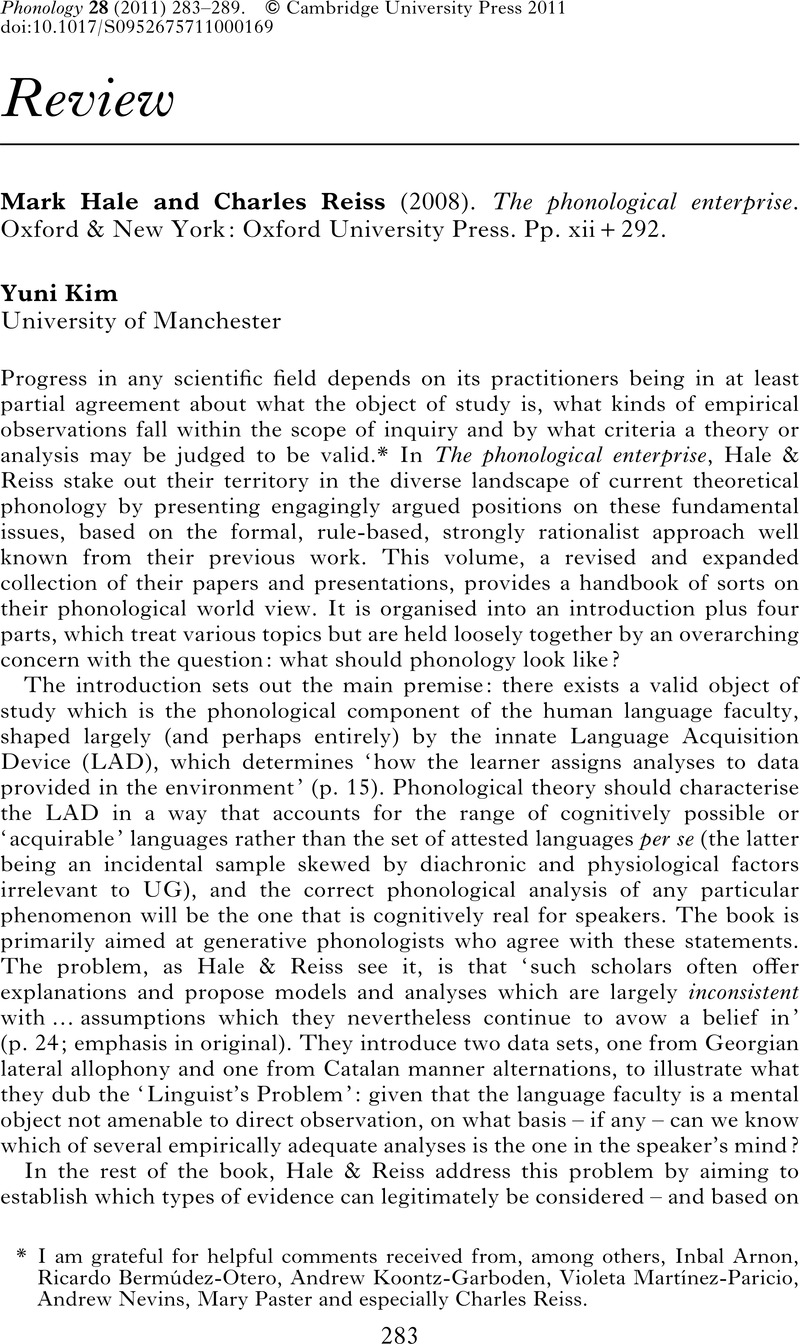No CrossRef data available.
Article contents
Mark Hale and Charles Reiss (2008). The phonological enterprise. Oxford & New York: Oxford University Press. Pp. xii+292.
Published online by Cambridge University Press: 21 July 2011
Abstract
An abstract is not available for this content so a preview has been provided. Please use the Get access link above for information on how to access this content.

- Type
- Book Review
- Information
- Copyright
- Copyright © Cambridge University Press 2011
References
REFERENCES
Anttila, Arto (2002). Variation and phonological theory. In Chambers, J. K., Trudgill, Peter & Schilling-Estes, Natalie (eds.) The handbook of language variation and change. Oxford: Blackwell. 206–243.Google Scholar
Blevins, Juliette (2004). Evolutionary Phonology: the emergence of sound patterns. Cambridge: Cambridge University Press.CrossRefGoogle Scholar
Boersma, Paul (forthcoming). Modelling phonological category learning. In Cohn, Abigail C., Fougeron, Cécile & Huffman, Marie K. (eds.) Handbook of laboratory phonology. Oxford: Oxford University Press.Google Scholar
Bresnan, Joan & Deo, Ashwini (2001). Grammatical constraints on variation: ‘be’ in the Survey of English Dialects and (stochastic) Optimality Theory. Ms, Stanford University.Google Scholar
Bresnan, Joan, Deo, Ashwini & Sharma, Devyani (2007). Typology in variation: a probabilistic approach to be and n't in the Survey of English Dialects. English Language and Linguistics 11. 301–346.CrossRefGoogle Scholar
Clark, Alexander & Lappin, Shalom (2011). Linguistic nativism and the poverty of the stimulus. Malden, Mass. & Oxford: Wiley-Blackwell.CrossRefGoogle Scholar
Coetzee, Andries W. & Pater, Joe (forthcoming). The place of variation in phonological theory. In Goldsmith, John A., Riggle, Jason & Yu, Alan (eds.) The handbook of phonological theory. 2nd edn. Oxford: Blackwell.Google Scholar
Fikkert, Paula (1995). From phonetic categories to phonological feature specification: acquiring the European Portuguese vowel system. Lingue e Linguaggio 4. 263–280.Google Scholar
Fikkert, Paula & Levelt, Clara (2008). How does Place fall into place? The lexicon and emergent constraints in children's developing phonological grammar. In Avery, Peter, Dresher, B. Elan & Rice, Keren (eds.) Contrast in phonology: theory, perception, acquisition. Berlin & New York: Mouton de Gruyter. 231–268.CrossRefGoogle Scholar
Flemming, Edward (2001). Scalar and categorical phenomena in a unified model of phonetics and phonology. Phonology 18. 7–44.CrossRefGoogle Scholar
Hale, Mark & Reiss, Charles (2008). The phonological enterprise. Oxford & New York: Oxford University Press.CrossRefGoogle Scholar
Hay, Jennifer (2000). Causes and consequences of word structure. PhD dissertation, Northwestern University.Google Scholar
Frans, Hinskens, van Hout, Roeland & Wetzels, W. Leo (eds.) (1997). Variation, change and phonological theory. Amsterdam & Philadelphia: Benjamins.Google Scholar
Johnson, Keith (1997). Speech perception without speaker normalization: an exemplar model. In Johnson, Keith & Mullenix, John W. (eds.) Talker variability in speech processing. San Diego: Academic Press. 145–165.Google Scholar
Kapp, Reginald O. (1958). Ockam's Razor and the unification of physical science. The British Journal for the Philosophy of Science 8. 265–280.CrossRefGoogle Scholar
Labov, William (1994). Principles of linguistic change. Vol. 1: Internal factors. Oxford & Cambridge, Mass.: Blackwell.Google Scholar
Marcus, Gary F. (1993). Negative evidence in language acquisition. Cognition 46. 53–85.CrossRefGoogle ScholarPubMed
Ohala, John J. (1983). The origin of sound patterns in vocal tract constraints. In MacNeilage, Peter F. (ed.) The production of speech. New York: Springer. 189–216.CrossRefGoogle Scholar
Petrova, Olga, Plapp, Rosemary, Ringen, Catherine & Szentgyörgyi, Szilárd (2006). Voice and aspiration: evidence from Russian, Hungarian, German, Swedish, and Turkish. The Linguistic Review 23. 1–35.CrossRefGoogle Scholar
Pierrehumbert, Janet B. (2001). Exemplar dynamics: word frequency, lenition and contrast. In Bybee, Joan & Hopper, Paul (eds.) Frequency and the emergence of linguistic structure. Amsterdam & Philadelphia: Benjamins. 137–157.CrossRefGoogle Scholar
Polka, Linda & Werker, Janet F. (1994). Developmental changes in perception of nonnative vowel contrasts. Journal of Experimental Psychology: Human Perception and Performance 20. 421–435.Google ScholarPubMed
Smolensky, Paul (1996). On the comprehension/production dilemma in child language. LI 27. 720–731.Google Scholar
Steriade, Donca (1997). Phonetics in phonology: the case of laryngeal neutralization. Ms, University of California, Los Angeles. Available (April 2011) at http://www.linguistics.ucla.edu/people/steriade/papers/phoneticsinphonology.pdf.Google Scholar
Werker, Janet F. & Tees, Richard C. (1984). Cross-language speech perception: evidence for perceptual reorganization during the first year of life. Infant Behaviour and Development 7. 49–63.CrossRefGoogle Scholar




